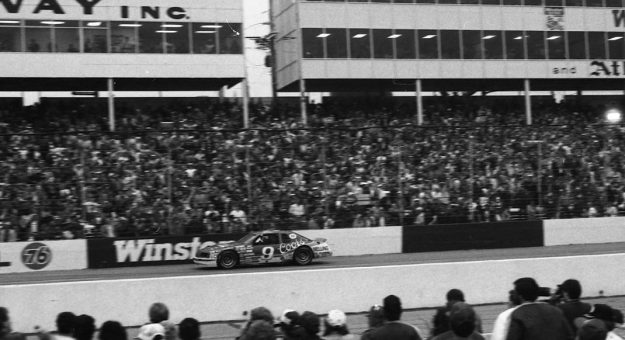During the 1976 Daytona 500, Wood Brothers Racing was using radios to communicate with David Pearson when he and Petty crashed racing to the checkered flag.
That day, one of the team’s crew members climbed on top of a pit road shelter to witness the outcome and convey what was happening to the crew.
By 1985, Wood Brothers Racing’s radio communication had improved through the help of a friend.
“I remember Kyle Petty was driving our car,” said Eddie Wood, co-owner of Wood Brothers Racing. “Mike Marcum owned a Ford dealership here in Stuart (Va.) and he was friends with us and friends with Kyle. The first race we used a spotter was the fall race at Bristol in 1985.
“We would buy him a grandstand seat. Wherever the race was a week or so ahead you would call them — you couldn’t go online then — and you would buy an actual ticket and they would mail it to you and that’s where he would sit during the race. Usually, we tried to get something, of course, up high as you could, but I remember Mike talking about all these fans that would be around him because he’s sitting there with a headset and a radio, which looked odd at that time.
“I guess people had scanners for a number of years even long before that, but to have one with a microphone and all that, it was different.”
In 1990, NASCAR mandated spotters for major races and, by 2002, required teams to have spotters for all 36 races. Wood feels having spotters is essential, especially with the safety advancements built into today’s race cars.
“It grew to what it is now and it’s so important with all the head gear and the difficulty for the driver to see the blind spots and stuff,” Wood explained. “Now, you can listen to any team throughout the race and the spotter is doing the most talking. In our case, Doug Campbell does a great job. He and Matt (DiBenedetto) have been together for a couple of years and they really understand each other’s wording, for lack of a better way to describe it. Matt’s always aware of what’s on his left, what’s on his right, what’s behind him, how far back, if somebody is coming. It’s amazing.
“I’ve spotted practice before and I’ve spotted a few races. I’ve spotted for Jon (Wood) when he was driving,” Wood continued. “It’s not an easy job and it wasn’t easy then, but now, I’m telling you, it would be like being an air traffic controller. There are two jobs I wouldn’t want to have in racing right now, one of them would be a spotter and the other would be a crew chief because they’re tough.”

Some top name drivers have been instrumental in advancing the art of spotting.
“Throughout the time I drove in NASCAR, I never had a spotter,” said 10-time NASCAR Cup Series winner Donnie Allison. “When I retired from driving, I did spot a few drivers in the early 1990s but then we did it from on top of the transporters in the garage area and not on the spotters’ stand outside the track. I remember spotting for Stanley Smith, a driver from Alabama, at Talladega in 1993. That’s the first time I can remember doing it for anybody I worked with. I’ve also spotted for Tony Stewart when he was driving.”
Some NASCAR drivers have become excellent spotters, including Andy Houston (Austin Dillon), Rick Carelli (Erik Jones), Coleman Pressley (Brad Keselowski) and Jason Jarrett (Ryan Newman).
It’s an art that takes perfect chemistry to pull off.
“This is our second year together and Brad (Keselowski) and I are still evolving,” Pressley said. “I feel like we’re on the same page but to get to that next level it takes time and certain situations; and learning from them and studying because the sport is always evolving. You have to stay focused on the prize ahead. It’s keeping everything in check and luckily, that’s where I’m really spoiled with Brad.
“He can keep a level head, more so than I could do as a driver.”
